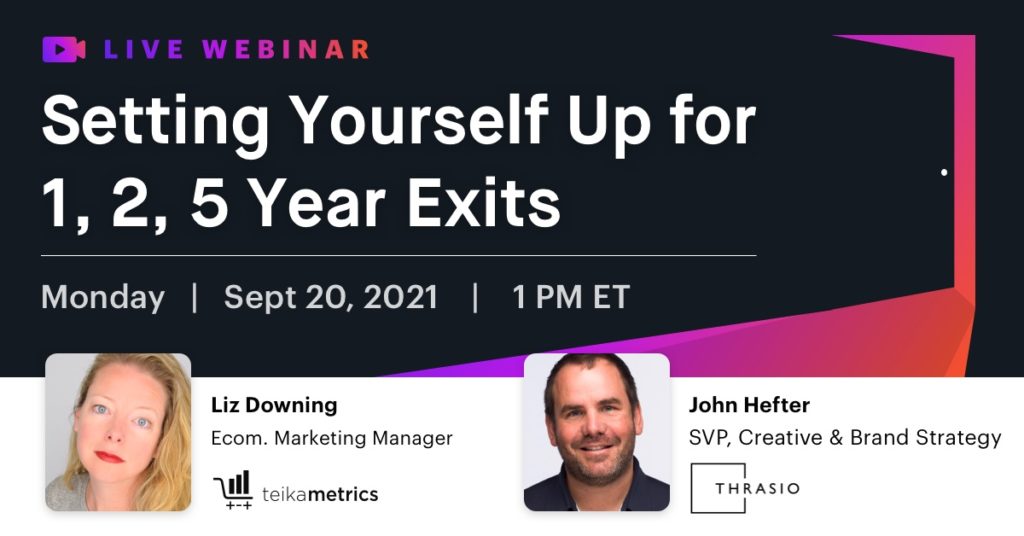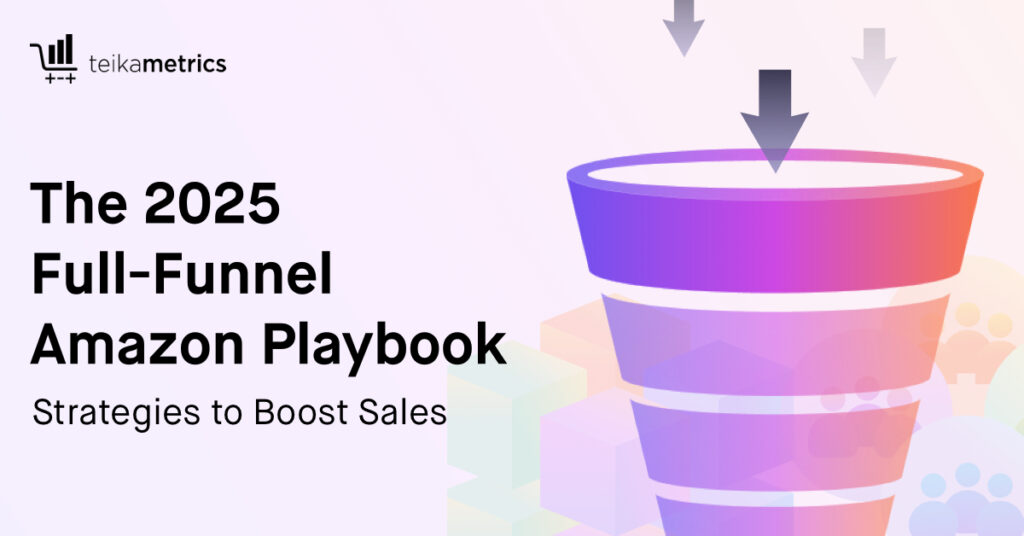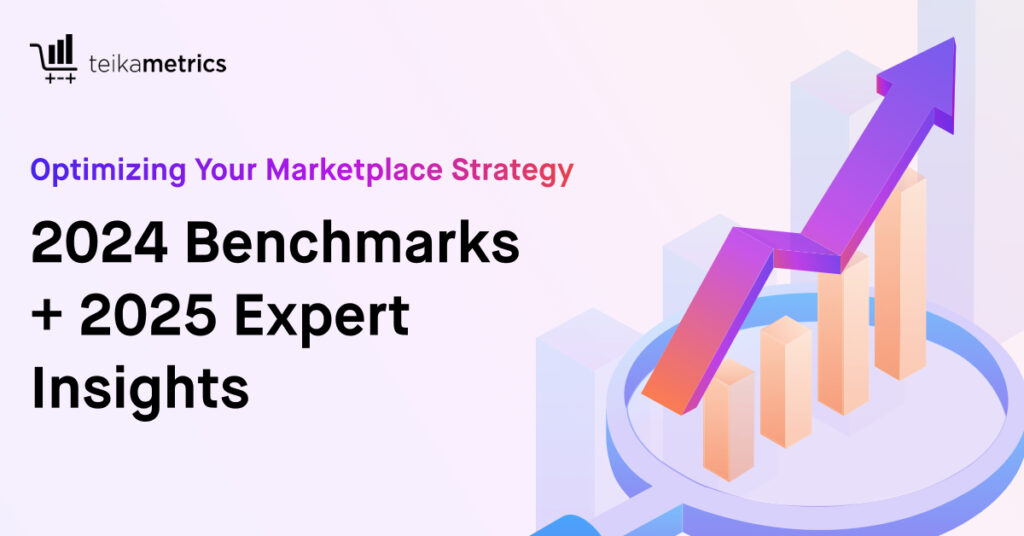Building a successful business means knowing when to hold on to your company and when to let it go. With the rise of ecommerce due to the pandemic, the M&A market has exploded with acquisitions for companies that sell through Amazon. But to get your business ready for acquisition, you must consider things like what products to leverage, whether branding is worth the hassle, and when to make that final deal. John Hefter, SVP of Creative and Brand Strategy at Thrasio, joined Teikametrics’ Ecommerce Marketing Manager Liz Downing to discuss how to get your company’s brand ready for an exit.
Webinar Teikaways
- Think like a customer
- Don’t underestimate simplicity
- Assess your business with a critical eye
- Leverage your bestsellers
- Build your business to succeed, not sell
- Think long-term to lessen your risks
- Have confidence in your choices
- Know when to brand
- Grow your business to get a better deal
Show Links
- Check out Thrasio
- Connect with John Hefter on LinkedIn
- Check out Teikametrics
- Connect with Teikametrics on Twitter or LinkedIn
Watch the Full Replay
Key Teika-ways
4:46 – Think like a customer
John said that as a seller, you should try to put yourself in the shoes of your potential buyer. Thinking like a customer will help you figure out where your brand needs improvement.
“When you’re an Amazon seller, you should always be thinking about, what does the customer want, right? So if you’re building new creative, if you’re making improvements to your product, whatever, your packaging, you should be obsessed with the idea of, what does my customer want to see? And if you’re thinking about selling your Amazon business to someone like a Thrasio or whoever else, you want to be asking yourself that same question. Put yourself in the mind of the customer, which in some cases might be us. So what would Thrasio want to see? What would anyone want to see? For me, I think what’s really hot in the market and something that’s always been intriguing to us is a sense of operational simplicity. And what I mean by that is if you had a business that had, making this up, three SKUs, all of them had a hundred thousand reviews, a 4.8 score, and you were doing 20 million a year on those ASINs, that might seem like you don’t have risk diversification. But for someone like a Thrasio, it’s exactly what we want.”
6:16 – Don’t underestimate simplicity
John said if you want your brand to appeal to a prospective buyer, it has to show potential for success. Don’t get caught up in elaborate plans when a simple, direct roadmap showcases your business in a better light.
John said if you want your brand to appeal to a prospective buyer, it has to show potential for success. Don’t get caught up in elaborate plans when a simple, direct roadmap showcases your business in a better light.
9:42 – Assess your business with a critical eye
John said to ask the hard questions when assessing your business so you can set yourself up for the best exit in the long term.
“There’s no universal formula of being a year away. I think it’s understanding an internal actuary table in your own head that says, what are the risks and benefits of me operating this brand for another year? And we’re coming out of a very complicated time right now. If you’ve been operating for a couple of years, what was that COVID bump like for you? Is it expiring? Could you leverage that in an exit now, to some degree? What’s your market doing? Are there people entering your space who are doing a better job? And can you be humble enough to admit that maybe in a year, this thing that you have is not as good as you could have? Are you really good at launching stuff, and you have a hit rate that’s super high? Then maybe you want to dive into that and set yourself up for a deal that allows you to have an earn-out in the backend. So even if your EBITDA shrinks a little bit because you’ve built these other new assets, and that obviously takes money to do that, right? You’re setting yourself up a position to have the best exit long-term.”
11:22 – Leverage your bestsellers
John said it’s easier to build on the success of your bestsellers than to start over from square one. Look at variations like size, color, or accessories as additional offerings instead of creating an entirely new product.
“There’s two schools of thought. One is all right, well, we’re a kitchen brand let’s say for this one. So we can go and we can find a pot and pan set, coffee maker, and we can continue our kitchen brand. But really at that point, you’re sort of starting from zero in a way, besides your past experience. And you’re hoping upon hope that your offering will be good enough and you’ll get it. Six times out of 10, you’ll get a positive result when you launch the thing. But you have this salt and pepper grinder, right? There’s a good chance that people really need salt. Then if you have that, you can just leverage your bestseller that’s getting all of these sessions, and you can sell the salt with the salt and pepper grinder as a way to leverage that asset to likely guarantee the chances that you will be successful. And then maybe it’s something as lucky as all right, is there a size offering? Is there a variation or something that I could do? A color that’s the second most popular in this space, and you only sell the top one? Where you can get an easy win to optimize the thing that you’ve already built and thus increase the proportionality of a success rate on the back end.”
13:32 – Build your business to succeed, not sell
John said businesses shouldn’t be built just to be sold. Build your company to succeed, even if that means following a nontraditional business model.
“I will say this: never build your business to sell, build your business to be successful first. So if you think it really needs a Shopify store to support the asset that you built, then do it, like, don’t stop the idea of not doing it. But understand the balance of the two things, right? And then also understand what type of brand you have. We’ve seen a lot of people have a nice asset on Amazon that’s like a ubiquitous staple item. Let’s say like a spatula for instance, we always use that as an example. And then they’ll build a DTC site, but it’s like, why? You think someone’s going to be scrolling Instagram and then see a special ad and they click on it? It’s not going to happen. You know what I mean? But some people don’t use that sort of common sense approach of like, should I be engaging in this activity? Is this actually worth me doing, or am I doing this to follow some sort of playbook written by someone else that’s not for your particular business?”
18:37 – Think long-term to lessen your risks
John said when your business scales too quickly, you often run into cash problems. To mitigate unnecessary risks, don’t try to build something you hope to sell right away.
“When you’re ramping an Amazon business and it’s going well, we run into this cash problem. Because your business is scaling like this, and you think it’s going to continue this way. But that means you have to order inventory for that scale, which means all the cash that you’ve earned here is going back into the business and you create this cycle. And then you’re always like, well, what if my market declines? What if a competitor comes in? What if I get a crazy attack? And then you’re doing 4 million a year, but you’re close to upside down. So for me, there’s something about building something to eventually sell, while not worrying about the selling piece, that then gives you some level of assurance. So you never have to be in a position where you wake up with the uncomfortable feeling of, ‘Everything’s at risk.’”
25:51 – Have confidence in your choices
John said that as an investor, buying circumstances are rarely ideal. You must make the choice that seems wisest for your current situation because you never know when things may change.
“I don’t have a crystal ball to see where this is going. But it’s something I would be cognizant of and trying to think of when to hit it. And everyone as an investor falls into this, ‘Oh, I’m not going to, I want to buy at the bottom, or I want to sell at the very top.’ It never works that way. You’re never going to make the perfect tactical decision. So for me, it’s like, all right, do I have a proxy for what seems like a wise decision at the time? So no matter what happens, I can look back and be like, ‘All things considered, I think it was the right choice relative to the time.’ Because you might wait for top market and then see the calls literally dry up.”
34:14 – Know when to brand
John said that branding your product isn’t necessary to sell your business. But having a brand creates a positive feedback loop that can grow your company, so it may be worth looking into.
“Brand registry we can get around and work with, it’s not a big deal. And we buy products all the time that are not completed brands yet. For us, it’s not bothersome. However, I would say if you think that creating a brand for this thing will get you meaningful differentiation that will lead to better unit session rates or conversion rates, whatever you want to call them, you should do it. If you think you know what you’re doing, it’s something you want to do, and you think you can actually make marked improvements. Because a lot of things start that positive feedback loop or the flywheel. But one is definitely conversion rate, and people would say brand doesn’t matter on Amazon, but brand always kind of matters.”
41:58 – Grow your business to get a better deal
John said that bigger businesses get better M&A offers. Weigh out whether it’s worth it to invest more time to grow your business so you’ll attract more interest when you eventually decide to sell.
“Whether you’re buying a business that does 500,000 a year or 500 million, the amount of work you do in diligence is very similar if it’s a pure Amazon business. You have to look at the value time of taking over a small business. When someone’s in the M&A space like we are, it’s a real weight to take. So having a business that’s really small, I’m sure there are people out there in the world who will put an offer for it. But the question is, is your time better spent saying, if you really have a great product, then getting some help to grow to be what it can be is probably a good use of your six months or a year of your life. So it’s not that you won’t get offers from people, you will, but know they certainly won’t be good as a proven thing.”
45:04 – Hold on to the magic
John said that if you own a business that you think has huge potential, make sure to hold on to a piece of it when you sell it in the M&A market. You don’t want to miss out on the success of your greatest idea.
“If you really think you have the magic and someone’s willing to pay you for it, and they’re not going to pay top dollar for it, because it hasn’t proven anything yet. And you really think it has magic, then you’d want a backend part of the juice, right? That’s what I love about so many of our deals. You take like the Angry Orange or whatever, you know, that seller’s super happy because he can only take it so far. And then we took it to this big heights and he was still getting paid for it. That’s a good outcome for everyone. So if you have something you think has the magic, make sure that you’re going to get a piece of the upside if you’re really sure of it.”





